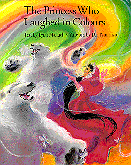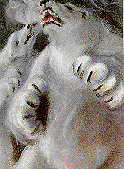

![]()

|
The Princess Who Laughed in Colours.
Lynn Manuel. Illustrated by J.O. Pennanen.
Grades 2 - 5 / Ages 7 - 10.
***/4
|
excerpt:
When the princess gazed out upon the silent emptiness, the steep cliffs on one side, the icy sea on the other, she wondered if she was doomed to dwell forever apart from her family and friends. Shivering in her thin dress, she wandered the land day after day in search of colours. And the warm breath of her sighs became white puffs in the cold wind.
THE PRINCESS WHO LAUGHED IN COLOURS is an admirable Canadian fairy tale. Princess Winona is admired everywhere not merely for her beauty and kindness, but for her laughter, which "was as golden and violet as the crown upon her head, as mellow green as an overgrown garden, as crimson and amber as a sunset, as royal blue as the sea."

A jealous queen in a neighbouring kingdom, worried about how undesirable (and unmarriageable) her daughters seem by comparison, places a curse on Winona, who awakes "in a barren northland where the sun gave no warmth."
Winona is trapped for some time in the North, at first frightened by its odd, colourless, dancing creatures (whales, polar bears, frost flies). Gradually she learns to appreciate them, and joins in their dance. And her resulting happy laughter brings spring to the northland, "as golden and violet as the crown upon her head, as mellow green as an overgrown garden, as crimson and amber as a sunset, as royal blue as the sea."
The spell broken, Princess Winona returns home, and every year thereafter her friends from the North come to visit, bringing the cold with them, a time that comes to be called "Winter."

J.O. Pennanen's excellent pastel illustrations work well -- the pictures of the eerie dances of the pale northern creatures, and the enveloping colours of Princess Winona's laughter are excellent. And Lynn Manuel's text does some real myth-making appropriate to this northern country: unexpectedly you find this conventional fairy tale has aspects of a creation story, explaining both spring in the arctic and winter in the rest of the world.
Perhaps the story relies too heavily on the concept of the Princess "who laughed in colours." The fairy-tale frame is a little too conventional at first (we probably don't need more stories about jealous curses that keep beautiful Princesses from finding appropriate princes); later it seems forgotten as the story ends in a rush -- Winona laughs, the spell is broken, and she (somehow) returns home.
Lynn Manuel's text uses repetition and repeated patterns well, but at times it seems stilted (and, for my taste, overuses exclamation marks). And -- though this is a very small point -- "Winona" is such a trendy name that it lacks a mythic feel.
But The Princess Who Laughed in Colours is a fine piece of Canadian myth-making. And whatever reservations I have about stories of princesses' marriage troubles, young girls seem to like them as much as ever. The attractive illustrations and central theme should make this a popular book.
Recommended.
Diane Fitzgerald is an elementary-school teacher in Saskatoon.
To comment on this title or this review, send mail to cmeditor@mts.net.
![]()
Copyright © 1996 the Manitoba Library Association.
Reproduction for personal use is permitted only if this copyright notice
is maintained. Any other reproduction is prohibited without permission.
Published by
The Manitoba Library Association
ISSN 1201-9364
![]()